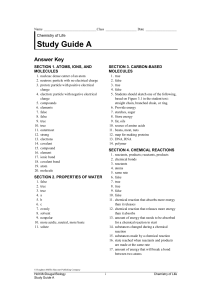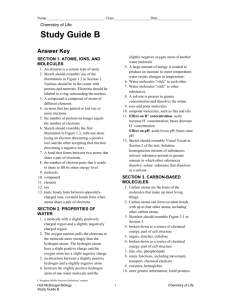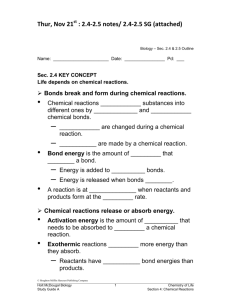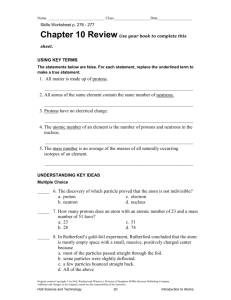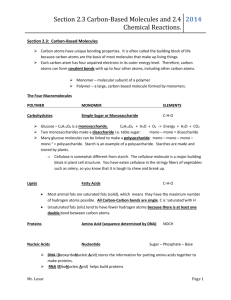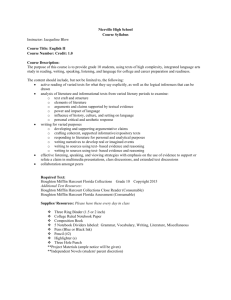Section 2.1 StudyGuideA
advertisement
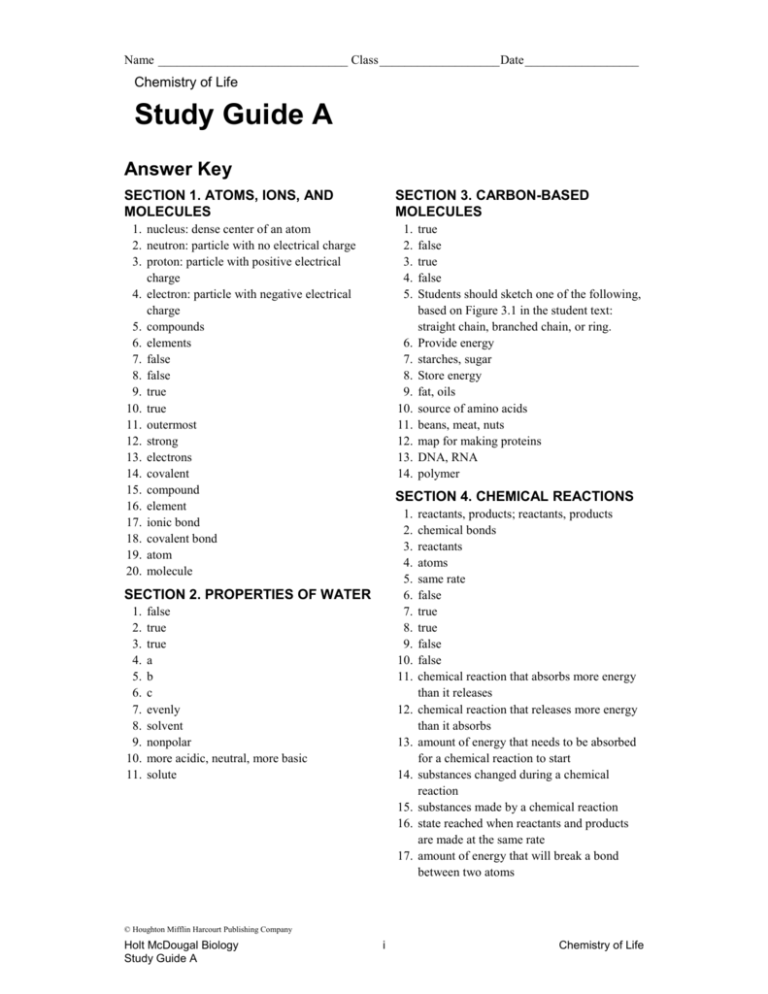
Name ______________________________ Class ___________________ Date __________________ Chemistry of Life Study Guide A Answer Key SECTION 1. ATOMS, IONS, AND MOLECULES SECTION 3. CARBON-BASED MOLECULES 1. nucleus: dense center of an atom 2. neutron: particle with no electrical charge 3. proton: particle with positive electrical charge 4. electron: particle with negative electrical charge 5. compounds 6. elements 7. false 8. false 9. true 10. true 11. outermost 12. strong 13. electrons 14. covalent 15. compound 16. element 17. ionic bond 18. covalent bond 19. atom 20. molecule 1. 2. 3. 4. 5. 6. 7. 8. 9. 10. 11. 12. 13. 14. SECTION 4. CHEMICAL REACTIONS 1. 2. 3. 4. 5. 6. 7. 8. 9. 10. 11. SECTION 2. PROPERTIES OF WATER 1. 2. 3. 4. 5. 6. 7. 8. 9. 10. 11. true false true false Students should sketch one of the following, based on Figure 3.1 in the student text: straight chain, branched chain, or ring. Provide energy starches, sugar Store energy fat, oils source of amino acids beans, meat, nuts map for making proteins DNA, RNA polymer false true true a b c evenly solvent nonpolar more acidic, neutral, more basic solute 12. 13. 14. 15. 16. 17. reactants, products; reactants, products chemical bonds reactants atoms same rate false true true false false chemical reaction that absorbs more energy than it releases chemical reaction that releases more energy than it absorbs amount of energy that needs to be absorbed for a chemical reaction to start substances changed during a chemical reaction substances made by a chemical reaction state reached when reactants and products are made at the same rate amount of energy that will break a bond between two atoms © Houghton Mifflin Harcourt Publishing Company Holt McDougal Biology Study Guide A i Chemistry of Life Name ______________________________ Class ___________________ Date __________________ Study Guide A continued SECTION 5. ENZYMES 1. 2. 3. 4. b c a (starting in upper left box and moving clockwise) in living things, temperature and pH, by speeding them up, by binding to the enzyme, making it possible for the reaction to take place 5. decrease 6. enzymes 7. Enzymes © Houghton Mifflin Harcourt Publishing Company Holt McDougal Biology Study Guide A ii Chemistry of Life Name ______________________________ Class ___________________ Date __________________ Section 1: Atoms, Ions, and Molecules Study Guide A KEY CONCEPT All living things are based on atoms and their interactions. VOCABULARY atom ion molecule element ionic bond compound covalent bond MAIN IDEA: Living things consist of atoms of different elements. Draw lines to connect the parts of an atom with their descriptions. 1. nucleus particle with a positive electrical charge 2. neutron particle with a negative electrical charge 3. proton particle with no electrical charge 4. electron dense center of an atom Circle the word or phrase that best completes the sentence. 5. Water (H2O) and carbon dioxide (CO2), are examples of compounds / elements. 6. Elements / Compounds are made up of only one type of atom. MAIN IDEA: Ions form when atoms gain or lose electrons. Choose whether the statement is true or false. 7. true / false An atom becomes an ion when its number of protons changes. 8. true / false Some ions are positively charged, and some ions have no charge. 9. true / false The formation of an ion results in a full outermost energy level. 10. true / false Ions usually form when electrons are transferred from one atom to another. © Houghton Mifflin Harcourt Publishing Company Holt McDougal Biology Study Guide A 1 Chemistry of Life Section 1: Atoms, Ions, and Molecules Name ______________________________ Class ___________________ Date __________________ Study Guide A continued MAIN IDEA: Atoms share pairs of electrons in covalent bonds. Circle the word or phrase that best completes the sentence. 11. Shared pairs of electrons fill the innermost / outermost energy levels of bonded atoms. 12. Covalent bonds are generally very strong / weak. 13. Two atoms may form several covalent bonds to share several pairs of protons / electrons. 14. A molecule is held together by ionic / covalent bonds. Vocabulary Check element compound ion ionic bond covalent bond atom molecule Write each word or phrase next to its definition. ____________________ 15. a substance made of atoms of different elements bonded together in a certain ratio ____________________ 16. a particular type of atom ____________________ 17. a bond formed by the electrical force between two ions of opposite charge ____________________ 18. a bond formed when two atoms share a pair of electrons ____________________ 19. the smallest basic unit of matter ____________________ 20. two or more atoms held together by covalent bonds © Houghton Mifflin Harcourt Publishing Company Holt McDougal Biology Study Guide A 2 Chemistry of Life Section 1: Atoms, Ions, and Molecules Name ______________________________ Class ___________________ Date __________________ Section 2: Properties of Water Study Guide A KEY CONCEPT Water’s unique properties allow life to exist on Earth. VOCABULARY hydrogen bond solution acid cohesion solvent base adhesion solute pH MAIN IDEA: Life depends on hydrogen bonds in water. Choose whether the statement is true or false. 1. true / false Polar molecules have two regions with a slight positive charge. 2. true / false Water is a polar molecule. 3. true / false Slightly charged regions of water molecules form hydrogen bonds. Choose the best answer for the question. 4. Which property allows water to resist changes in temperature? a. high specific heat b. cohesion c. adhesion d. polarity 5. Which property causes water to form beads? a. high specific heat b. cohesion c. adhesion d. polarity 6. Which property of water helps plants to transport water from their roots to their leaves? a. high specific heat b. cohesion c. adhesion d. polarity © Houghton Mifflin Harcourt Publishing Company Holt McDougal Biology Study Guide A 3 Chemistry of Life Section 2: Properties of Water Name ______________________________ Class ___________________ Date __________________ Study Guide A continued MAIN IDEA: Many compounds dissolve in water. Circle the word or phrase that best completes the sentence. 7. A solution is a mixture of substances that is evenly / unevenly distributed throughout the entire mixture. 8. Blood plasma is an example of a solvent / solute. 9. “Oil and water don’t mix” because a polar / nonpolar molecule can’t easily dissolve in a polar solvent. MAIN IDEA: Some compounds form acids or bases. 10. In the pH table below, add labels to show which side of the table shows pHs that are more acidic, and which side shows pHs that are more basic. Then add a label to show which pH is neutral. 1 2 3 4 5 6 7 8 9 10 11 12 13 14 ____________________________________________________________ Vocabulary Check Fill in the blank with either solvent or solute. 11. A __________ dissolves in a solution. © Houghton Mifflin Harcourt Publishing Company Holt McDougal Biology Study Guide A 4 Chemistry of Life Section 2: Properties of Water Name ______________________________ Class ___________________ Date __________________ Section 3: Carbon-Based Molecules Study Guide A KEY CONCEPT Carbon-based molecules are the foundation of life. VOCABULARY monomer lipid amino acid polymer fatty acid nucleic acid carbohydrate protein MAIN IDEA: Carbon atoms have unique bonding properties. Choose whether the statement is true or false. 1. true / false Carbon atoms form the building blocks of most living things. 2. true / false Carbon’s outer energy level is full. 3. true / false Carbon atoms can form covalent bonds with up to four other atoms. 4. true / false The three basic structures of carbon-based molecules are straight chain, bent chain, and ring. 5. Choose one of the three basic structures of carbon-based molecules to sketch in the space below. Label your sketch with the name of the basic structure. © Houghton Mifflin Harcourt Publishing Company Holt McDougal Biology Study Guide A 5 Chemistry of Life Section 3: Carbon-Based Molecules Name ______________________________ Class ___________________ Date __________________ Study Guide A continued MAIN IDEA: Four main types of carbon-based molecules are found in living things. Complete the table with the functions and examples provided for each type of carbon-based molecule. Functions Examples Provide energy meat fat oils Building blocks of proteins sugar beans DNA Map for making proteins starches nuts RNA Store energy Molecule Type Functions Examples Carbohydrate 6. 7. Lipid 8. 9. Protein 10. 11. Nucleic acid 12. 13. Vocabulary Check 14. The prefix mono- means “one,” and the prefix poly- means “many.” Which contains more molecules, a monomer or a polymer? _____________________ © Houghton Mifflin Harcourt Publishing Company Holt McDougal Biology Study Guide A 6 Chemistry of Life Section 3: Carbon-Based Molecules Name ______________________________ Class ___________________ Date __________________ Section 4: Chemical Reactions Study Guide A KEY CONCEPT Life depends on chemical reactions. VOCABULARY chemical reaction bond energy exothermic reactant equilibrium endothermic product activation energy MAIN IDEA: Bonds break and form during chemical reactions. 1. Label the reactants and products in the chemical reactions shown below. ______________________________ CH4 + 2O2 CO2 + 2H2O ________________________________ ______________________________ 6CO2 + 6H2O 6O2 + C6H12O6 ________________________________ Circle the word or phrase that best completes the sentence. 2. During a chemical reaction, chemical bonds / solutes break and reform. 3. Reactants / products are the substances changed during a chemical reaction. 4. Bond energy is the amount of energy it takes to break a bond between two atoms / ions. 5. Equilibrium occurs when reactants and products are made at the same rate / different rates. © Houghton Mifflin Harcourt Publishing Company Holt McDougal Biology Study Guide A 7 Chemistry of Life Section 4: Chemical Reactions Name ______________________________ Class ___________________ Date __________________ Study Guide A continued MAIN IDEA: Chemical reactions release or absorb energy. Choose whether the statement is true or false. 6. true / false Not all chemical reactions involve changes in energy. 7. true / false Activation energy is required for a chemical reaction to start. 8. true / false Some chemical reactions release more energy than they absorb, while others absorb more energy than they release. 9. true / false Chemical reactions can occur whether or not energy is added to the reactants. 10. true / false An exothermic chemical reaction absorbs more energy than it releases. Vocabulary Check Draw lines to connect the words or phrases that mean the same thing. 11. endothermic reaction substances changed during a chemical reaction 12. exothermic reaction substances made by a chemical reaction 13. activation energy chemical reaction that releases more energy than it absorbs 14. reactants chemical reaction that absorbs more energy than it releases 15. products amount of energy that needs to be absorbed for a chemical reaction to start 16. equilibrium amount of energy that will break a bond between two atoms 17. bond energy state reached when reactants and products are made at the same rate © Houghton Mifflin Harcourt Publishing Company Holt McDougal Biology Study Guide A 8 Chemistry of Life Section 4: Chemical Reactions Name ______________________________ Class ___________________ Date __________________ Section 5: Enzymes Study Guide A KEY CONCEPT Enzymes are catalysts for chemical reactions in living things. VOCABULARY catalyst substrate enzyme MAIN IDEA: A catalyst lowers activation energy. Choose the best answer to the question. 1. Activation energy is the energy required to a. complete a chemical reaction. b. start a chemical reaction. c. produce a catalyst. d. produce the reactants. 2. Which of the following can reduce the amount of energy needed for a chemical reaction to take place? a. reactant b. product c. catalyst d. hydrogen bond 3. What happens to the speed of a chemical reaction when a catalyst is present? a. It speeds up. b. It slows down. c. It stays the same. d. It becomes erratic. © Houghton Mifflin Harcourt Publishing Company Holt McDougal Biology Study Guide A 9 Chemistry of Life Section 5: Enzymes Name ______________________________ Class ___________________ Date __________________ Study Guide A continued MAIN IDEA: Enzymes allow chemical reactions to occur under tightly controlled conditions. 4. Take notes about enzymes by filling in the Main Idea Web below. What physical factors affect the action of enzymes? Where do enzymes act as catalysts? Enzymes How do enzymes affect the speed of chemical reactions in the body? How does a substrate affect an enzyme? Vocabulary Check Circle the word or phrase that best completes the sentence. 5. A catalyst can increase / decrease the amount of energy needed to start a chemical reaction. 6. Substrates are to catalysts / enzymes as keys are to locks. 7. Enzymes / substrates are catalysts for chemical reactions in living things. © Houghton Mifflin Harcourt Publishing Company Holt McDougal Biology Study Guide A 10 Chemistry of Life Section 5: Enzymes
